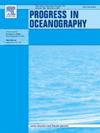The role of atmospheric iron deposition in driving carbon uptake over the Indian Ocean
IF 3.6
3区 地球科学
Q1 OCEANOGRAPHY
引用次数: 0
Abstract
The Indian Ocean (IO) is characterized by large gradients in atmospheric aerosols and is also an important sink region for atmospheric CO2. However, there are major gaps in our understanding of the linkages between micronutrient dissolved iron (DFe) derived from aerosol over the IO, and the responses of phytoplankton, uptake of CO2 by the upper ocean, and subsequent CO2 sequestration. The present study carries out simulations with an Earth system model to assess the importance of atmospheric sources of DFe in driving the uptake of CO2 over the IO. The results reveal that along with a general increase in upper ocean phytoplankton following atmospheric DFe addition, there are important shifts in phytoplankton functional types. Such shifts impact the dominant biomineral flux and alter the efficiency of export of particulate organic carbon out of the surface mixed layer. The shifts in phytoplankton functional types also largely offset ocean CO2 uptake from positive biological response by reducing surface alkalinity owing to increase in calcium carbonate flux. The dominance of calcium carbonate flux over the Southern Ocean sector of the IO results in net outgassing of CO2 over this region in response to present day atmospheric DFe addition. While the deep ocean carbon sequestration, as indicated by the remineralization length scale of particulate organic carbon, is controlled by ballasting effects of mineral dust over the high-dust northern IO, it is a function of ecosystem structure over the low-dust southern IO. The magnitude and the type of phytoplankton response to atmospheric DFe plays a crucial role in driving the surface-to-deep ocean gradients in dissolved inorganic carbon and alkalinity with the greatest contribution to subsurface dissolved inorganic carbon (alkalinity) response originating from the gas-exchange (carbonate) pump. At interannual timescales, the phytoplankton response to atmospheric sources of DFe depends on availability of nitrate over the northern IO, while phytoplankton response over the southern IO is strongly coupled to the variability of atmospheric iron flux. These results help disentangle the relation between atmospheric deposition of DFe, availability of major nutrients, and phytoplankton functional types and spatial and temporal variation in the net ocean CO2 uptake.
大气中铁沉积在推动印度洋上空碳吸收中的作用
印度洋是大气气溶胶梯度大的地区,也是大气CO2的重要汇区。然而,我们对气溶胶中微量元素溶解铁(DFe)与浮游植物的反应、上层海洋对二氧化碳的吸收以及随后的二氧化碳封存之间的联系的理解存在重大差距。本研究利用地球系统模型进行了模拟,以评估大气中DFe源在驱动IO上空CO2吸收方面的重要性。结果表明,大气中添加DFe后,随着上层海洋浮游植物数量的普遍增加,浮游植物的功能类型也发生了重要变化。这种变化影响了主要的生物矿物通量,并改变了颗粒有机碳从表面混合层出口的效率。浮游植物功能类型的变化也在很大程度上抵消了由于碳酸钙通量增加而降低表面碱度的积极生物反应对海洋二氧化碳的吸收。碳酸钙通量在IO的南大洋部分占主导地位,导致该区域的二氧化碳净排放,以响应当前大气中DFe的添加。颗粒有机碳再矿化长度尺度表明,深海固碳主要受北部高沙尘地区矿物粉尘的压舱作用控制,而南部低沙尘地区则受生态系统结构的影响。浮游植物对大气DFe响应的大小和类型在驱动表层到深海溶解无机碳和碱度的梯度中起着至关重要的作用,其中对源自气体交换(碳酸盐)泵的地下溶解无机碳(碱度)响应贡献最大。在年际时间尺度上,浮游植物对大气DFe源的响应取决于北部IO的硝酸盐可用性,而南部IO的浮游植物响应与大气铁通量的变率密切相关。这些结果有助于理清大气DFe沉积、主要营养物有效性和浮游植物功能类型与海洋净CO2吸收的时空变化之间的关系。
本文章由计算机程序翻译,如有差异,请以英文原文为准。
求助全文
约1分钟内获得全文
求助全文
来源期刊

Progress in Oceanography
地学-海洋学
CiteScore
7.20
自引率
4.90%
发文量
138
审稿时长
3 months
期刊介绍:
Progress in Oceanography publishes the longer, more comprehensive papers that most oceanographers feel are necessary, on occasion, to do justice to their work. Contributions are generally either a review of an aspect of oceanography or a treatise on an expanding oceanographic subject. The articles cover the entire spectrum of disciplines within the science of oceanography. Occasionally volumes are devoted to collections of papers and conference proceedings of exceptional interest. Essential reading for all oceanographers.
 求助内容:
求助内容: 应助结果提醒方式:
应助结果提醒方式:


